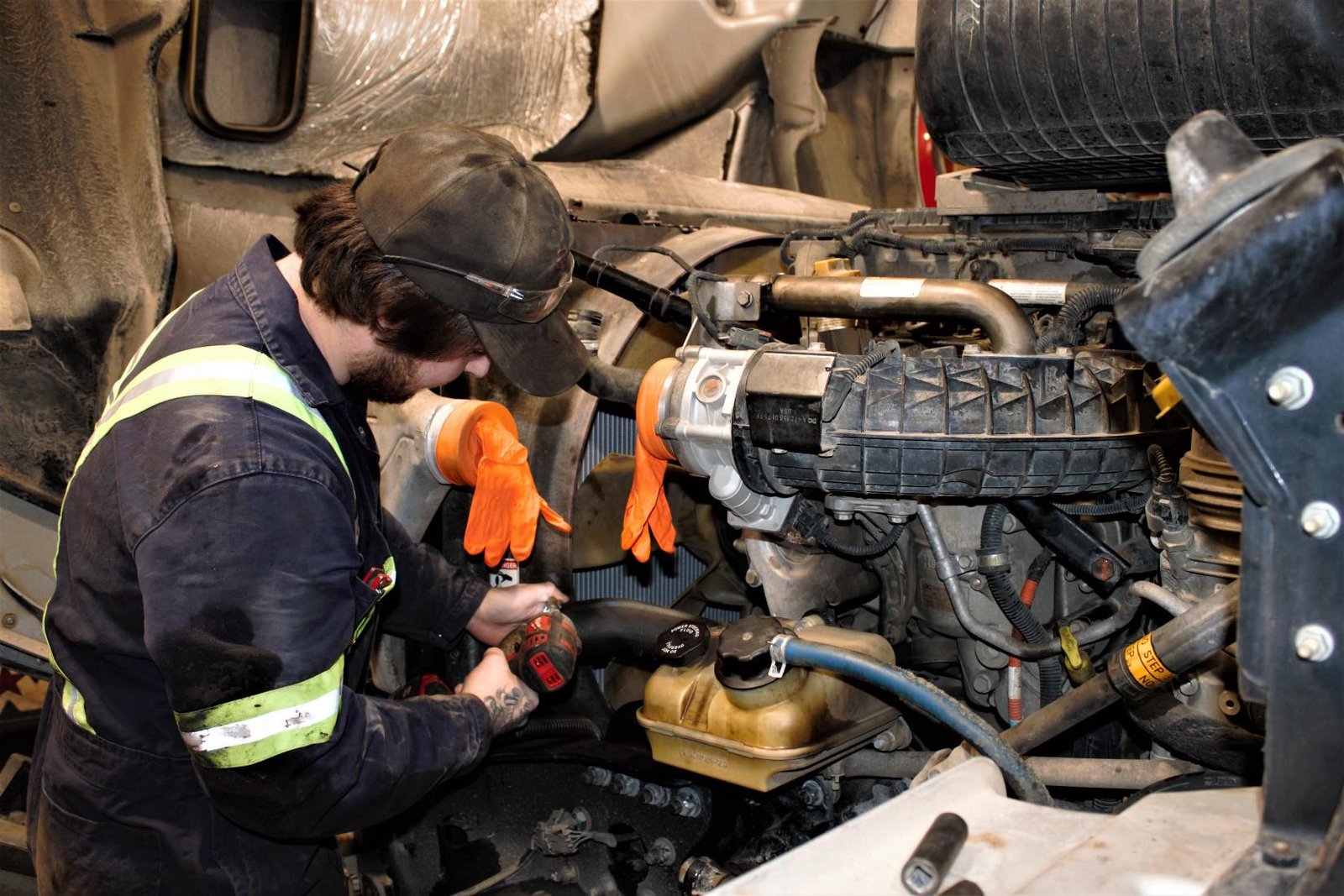Maintaining your truck for peak performance is essential for ensuring safety, reliability, and efficiency. Regular upkeep not only helps prevent unexpected breakdowns but also extends the life of your vehicle and improves fuel efficiency. In this comprehensive guide, we’ll cover all aspects of truck maintenance, offering practical tips and advice to keep your truck running smoothly.
Also check LTL vs FTL , Conestoga Trailer , 53 ft dry vans trucking
1. Regular Oil Changes
Why Oil Changes Matter: Engine oil is crucial for lubricating moving parts, reducing friction, and preventing overheating. Over time, oil breaks down and becomes less effective, which can lead to engine wear and decreased performance.
How to Maintain Proper Oil Levels:
- Check Oil Level: Use the dipstick to check the oil level regularly, ideally before every long trip or once a week.
- Change Oil: Follow the manufacturer’s recommendations for oil change intervals, which is typically every 30,000 to 40,000 miles. However, severe driving conditions may require more frequent changes.
- Replace Oil Filter: The oil filter should be replaced with every oil change to ensure clean oil flow and optimal engine performance.
Additional Tips:
- Use Quality Oil: Choose the recommended oil type and grade specified in your truck’s owner manual.
- Monitor Oil Pressure: Keep an eye on the oil pressure gauge and address any irregularities promptly.
2. Tire Maintenance
Why Proper Tire Care is Essential: Tires are the only contact between your truck and the road. Proper tire maintenance is vital for safety, fuel efficiency, and overall vehicle performance.
How to Maintain Your Tires:
- Check Tire Pressure: Ensure tires are inflated to the manufacturer’s recommended pressure. Check pressure monthly and before long trips.
- Inspect Tire Tread: Use a tread depth gauge to measure the tread depth. Replace tires with less than 4/32” of tread depth to maintain traction and safety.
- Rotate Tires: Rotate tires every 40,000 to 50,000 miles to promote even wear and extend their lifespan.
Additional Tips:
- Check for Uneven Wear: Regularly inspect tires for signs of uneven wear, which could indicate alignment or suspension issues.
- Balance Tires: Ensure tires are properly balanced to prevent vibrations and uneven wear.
3. Brake System Maintenance
Why Brake Maintenance is Crucial: The brake system is essential for vehicle safety and control. Regular maintenance ensures reliable braking performance and prevents potential accidents.
How to Maintain Your Brakes:
- Inspect Brake Pads: Check brake pads for wear. Replace them if they are less than 1/4” thick.
- Check Brake Fluid: Ensure the brake fluid level is at the recommended level. Top it off if necessary and replace it according to the manufacturer’s guidelines, typically every 2 years.
- Examine Rotors and Drums: Inspect brake rotors and drums for signs of wear or damage. Replace them if they show significant grooves or scoring.
Additional Tips:
- Listen for Noise: Pay attention to any squealing or grinding noises when braking, which could indicate worn brake components.
- Monitor Brake Response: If you notice a spongy brake pedal or reduced braking performance, have your brakes inspected immediately.
4. Cooling System Maintenance
Why the Cooling System is Important: The cooling system prevents the engine from overheating and ensures it operates efficiently. Proper maintenance helps avoid engine damage and overheating issues.
How to Maintain Your Cooling System:
- Check Coolant Levels: Regularly check the coolant level and ensure it is at the appropriate level. Add coolant if necessary, using the type recommended in the owner’s manual.
- Flush and Replace Coolant: Follow the manufacturer’s recommendations for flushing and replacing coolant, typically every 2 to 3 years.
- Inspect Hoses and Belts: Check for signs of wear, leaks, or damage in hoses and belts. Replace any that show signs of deterioration.
Additional Tips:
- Check for Leaks: Regularly inspect the cooling system for leaks around hoses, the radiator, and the water pump.
- Monitor Temperature Gauge: Keep an eye on the engine temperature gauge and address any overheating issues promptly.
5. Battery Maintenance
Why Battery Care is Essential: A well-maintained battery ensures reliable starting and optimal vehicle performance. Regular maintenance can help prevent unexpected battery failures.
How to Maintain Your Battery:
- Check Battery Charge: Test the battery’s charge level regularly using a multimeter or battery tester.
- Inspect for Corrosion: Look for corrosion around the battery terminals. Clean any corrosion with a battery terminal cleaner or a mixture of baking soda and water.
- Replace Battery: Replace the battery every 3 to 5 years or when it shows signs of failure, such as difficulty starting the engine.
Additional Tips:
- Secure Battery: Ensure the battery is securely mounted to prevent vibration damage.
- Keep Battery Clean: Keep the battery and surrounding area clean to prevent buildup that can affect performance.
6. Air Filter Maintenance
Why Air Filters are Important: Air filters ensure that the engine receives clean air for combustion, which is crucial for optimal performance and fuel efficiency.
How to Maintain Air Filters:
- Check Air Filter: Regularly inspect the air filter for dirt and debris. Replace it if it appears clogged or dirty.
- Replace Cabin Air Filter: Ensure the cabin air filter is clean to maintain good air quality inside the truck.
Additional Tips:
- Inspect Air Filter Regularly: Check the air filter during routine maintenance or oil changes to ensure it is clean.
- Use Quality Filters: Choose high-quality filters that meet or exceed the manufacturer’s specifications.
7. Transmission Maintenance
Why Transmission Care is Crucial: Proper transmission maintenance ensures smooth shifting and vehicle performance. Regular upkeep helps avoid costly repairs and extends the life of the transmission.
How to Maintain Your Transmission:
- Check Transmission Fluid: Regularly check the transmission fluid level and top it off if necessary. Follow the manufacturer’s recommendations for fluid type and level.
- Flush Transmission: Follow the manufacturer’s guidelines for flushing and replacing transmission fluid, usually every 30,000 to 60,000 miles.
Additional Tips:
- Listen for Transmission Issues: Pay attention to any unusual noises or hard shifting, which could indicate transmission problems.
- Monitor Fluid Color: Check the color of the transmission fluid. It should be red or pink. If it appears dark or brown, it may need to be replaced.
8. Lights and Electrical System Maintenance
Why Functional Lights and Electrical Systems are Important: Working lights and electrical systems are crucial for safety and operational efficiency. Proper maintenance ensures visibility and functionality.
How to Maintain Lights and Electrical Systems:
- Check All Lights: Regularly inspect headlights, brake lights, turn signals, and other lights to ensure they are working correctly.
- Inspect Electrical System: Check for any signs of electrical issues, such as flickering lights or malfunctioning accessories. Address these issues promptly.
Additional Tips:
- Replace Bulbs Promptly: Replace any burnt-out bulbs as soon as possible to maintain safety.
- Secure Wiring: Ensure all wiring is secure and free from damage to prevent electrical problems.
Conclusion Regular maintenance is key to keeping your truck running at peak performance. By following these comprehensive maintenance tips and addressing any issues promptly, you can ensure your truck remains reliable, efficient, and safe. Implementing a regular maintenance schedule will help you avoid unexpected breakdowns and costly repairs, keeping your truck in top shape for the road ahead.




